Related Research Articles

The Gulf of California, also known as the Sea of Cortés or Sea of Cortez, or less commonly as the Vermilion Sea, is a marginal sea of the Pacific Ocean that separates the Baja California peninsula from the Mexican mainland. It is bordered by the states of Baja California, Baja California Sur, Sonora, and Sinaloa with a coastline of approximately 4,000 km (2,500 mi). Rivers that flow into the Gulf of California include the Colorado, Fuerte, Mayo, Sinaloa, Sonora, and the Yaqui. The surface of the gulf is about 160,000 km2 (62,000 sq mi). Maximum depths exceed 3,000 meters (9,800 ft) because of the complex geology, linked to plate tectonics.
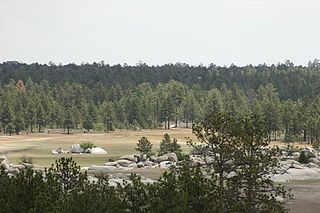
Baja California, officially Estado Libre y Soberano de Baja California, is a state in Mexico. It is the northernmost and westernmost of the 32 federal entities of Mexico. Before becoming a state in 1952, the area was known as the North Territory of Baja California. It has an area of 70,113 km2 (27,071 sq mi) and comprises the northern half of the Baja California peninsula, north of the 28th parallel, plus oceanic Guadalupe Island. The mainland portion of the state is bordered on the west by the Pacific Ocean; on the east by Sonora, the U.S. state of Arizona, and the Gulf of California; on the north by the U.S. state of California; and on the south by Baja California Sur.
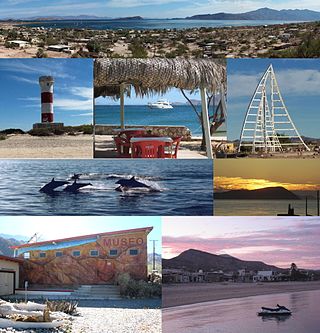
Bahía de los Ángeles is a coastal bay on the Gulf of California, located along the eastern shore of the Baja California Peninsula in the state of Baja California, Mexico. The town of the same name is located at the east end of Federal Highway 12 about 42 miles (68 km) from the Parador Punta Prieta junction on Federal Highway 1. The area is part of the San Quintín Municipality.

Ensenada is a city in Ensenada Municipality, Baja California, situated on the Pacific Coast of Mexico. Located on the Bahía de Todos Santos, the city had a population of 279,765 in 2018, making it the third-largest city in Baja California. The city is an important international trade center and home to the Port of Ensenada, the second-busiest port in Mexico. Ensenada is a major tourist destination, owing to its warm climate and proximity to the Pacific Ocean, and is commonly known as La Cenicienta del Pacífico.

Rosarito is a coastal city in Playas de Rosarito Municipality, Baja California, on the Pacific Coast of Mexico. As of 2010, the city had a population of 65,278. Located 10 miles (16 km) south of the US–Mexico border, Rosarito is a part of the greater San Diego–Tijuana region and one of the westernmost cities in Mexico. Rosarito is a major tourist destination, known for its beaches, resorts, and events like Baja Beach Fest.

San Ignacio is a town in Mulegé Municipality, Baja California Sur. The town had a 2020 census population of 521.

The Valle de Guadalupe is an agricultural region in the Ensenada Municipality, Baja California, Mexico that produces an estimated 70 percent of Mexican wine. In recent years, it has become a popular tourist destination for wine and Baja Med cuisine.

The Spanish missions in Baja California were a large number of religious outposts established by Catholic religious orders, the Jesuits, the Franciscans and the Dominicans, between 1683 and 1834. The missionary goal was to spread the Christian doctrine among the Indigenous peoples living on the Baja California peninsula. The missions gave Spain a valuable toehold in the frontier land, and would also act as a deterrent to prevent pirates from using the peninsula of Las Californias as a jumping off point for contraband trade with mainland New Spain. Missionaries introduced European livestock, fruits, vegetables, and industry into the region. Indigenous peoples were severely impacted by the introduction of European diseases such as smallpox and measles; furthermore, the expulsion of the Jesuits from the Spanish Empire in 1767 ripped the social fabric of the peninsula, although Franciscans were sent to replace them. In 1769, the Franciscans moved to Upper California, leaving Dominicans in charge of Baja California. By 1800 indigenous numbers were a fraction of what they had been before the arrival of the Spanish, yet even today many people living in Baja California are of indigenous heritage.
Mission San Bruno was a short-lived Spanish mission established by Jesuit order on October 7, 1684, in what is now the Loreto Municipality of Baja California Sur, Mexico. The mission was the first Spanish mission established on the Baja California Peninsula.
Francisco Palóu , OFM (1723–1789) was a Spanish Franciscan missionary, administrator and historian on the Baja California Peninsula and in Alta California. Palóu made significant contributions to the Alta California and Baja California mission systems. Along with his mentor, Junípero Serra, Palóu worked to build numerous missions throughout Alta and Baja California, many structures of which still stand today. A member of the Franciscan Order, Palóu became "Presidente" of the missions in Baja California, and later of missions of Alta California. Palóu's work in the Spanish mission system spans from his early twenties to his death at the age of 66.

The Californias, occasionally known as the Three Californias or the Two Californias, are a region of North America spanning the United States and Mexico, consisting of the U.S. state of California and the Mexican states of Baja California and Baja California Sur. Historically, the term Californias was used to define the vast northwestern region of Spanish America, as the Province of the Californias, and later as a collective term for Alta California and the Baja California Peninsula.
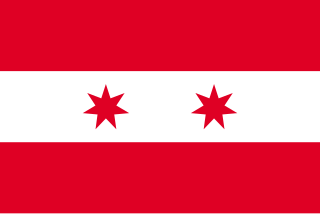
The Republic of Baja California and Sonora or more simply known as the Republic of Sonora was a short-lived, unrecognized federal republic ruled by filibuster William Walker in 1854. It was based in Baja California and also claimed Sonora. Walker's actions generated interest back in San Francisco, where bonds for the Republic of Sonora were sold, and its flag was even raised in places. His enterprise, however, suffered from a lack of supplies and discontent from within; the Mexican government quickly forced Walker to retreat.
George H. Sisson was a nineteenth-century American entrepreneur. He was born in Michigan, and was an early real estate developer in Chicago. He was a mining engineer in Arizona, and with his profits from that operation, purchased a large land concession in Baja California.

The Republic of Lower California, also known as the Republic of Baja California was a proposed state from 1853 to 1854, after American private military leader William Walker failed to invade Sonora from Arizona. Walker wanted to appropriate Sonora, and his claims had both the support of tycoons and government complacency in the United States.

The Second Battle of Tijuana was fought during the Mexican Revolution in June 1911. The opposing sides were rebel Magonistas and federal Mexican troops of President Francisco León de la Barra with American militia volunteers from Los Angeles, California. Tijuana was retaken by federal forces after a short battle just south of the town.
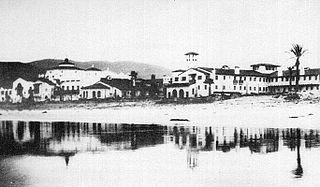
The Hotel Riviera del Pacífico was a hotel located in Ensenada, Baja California, Mexico. It was one of the most prestigious and luxurious hotels in Mexico.

William Michael Mathes was an American historian and academic who focused on the histories of Mexico and Spain. Mathes was a leading expert on the history of Baja California. His articles can be found in the California Historical Society Quarterly, Southern California Quarterly, Journal of San Diego History, Journal of California Anthropology, Pacific Coast Archaeological Society Quarterly, Calafia, Meyibó, and other publications.
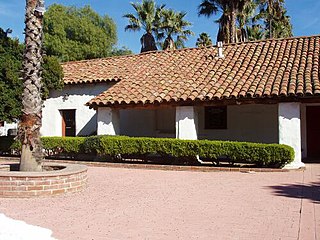
Asistencias or visitas were smaller sub-missions of Catholic missions established during the 16th-19th centuries of the Spanish colonization of the Americas and the Philippines. They allowed the Catholic church and the Spanish crown to extend their reach into native populations at a modest cost.

The William Walker Filibuster Expedition to Baja California and Sonora occurred in the year of 1853, after a failed attempt by Walker himself to invade Sonora from the Arizona border. William Walker sought to appropriate Sonora, and in his claims he had the support of magnates and the complacency of the United States government. In November 1853 he embarked with two hundred men towards La Paz, where he was able to capture the political chief and proclaimed the independence of the Republic of Baja California, a state that never had recognition nor did it exist in the facts, since Walker never had total control of the peninsula or had the support of the population. Rather, he faced resistance from the army and Mexican civilians, among which the group commanded by Antonio Meléndrez stands out. In spite of being folded in Ensenada and suffering the mutiny of his troops from the United States, Walker proclaimed himself president of the Republic of Sonora, which also included Baja California and that, like its successor, did not have existence in fact nor any recognition. In fact, Walker only reached the territory of Sonora in 1854 when pressured by the navy of the United States and Mexico, he had to flee Ensenada. Before the harassment of Meléndrez and the desertion of another part of his troops, Walker and the remnant of his filibuistero army surrendered in San Diego to the American army. Taken to trial, the judge said he was guilty of violating the Neutrality Law signed between Mexico and the United States after the US invasion of Mexico in 1847. However, Walker was acquitted by the jury.

José Matías Moreno II (1819–1869) was secretary of state under Pío Pico, the last Mexican governor of California; a Mexican patriot; and a major landowner in the Guadalupe Valley, Baja California, Mexico.
References
- 1 2 3 4 5 6 7 8 9 10 David Goldbaum, Son of Jewish Pioneer in Mexico, Dies at 71, Jewish Telegraphic Agency, March 12, 1930
- ↑ Susan Michno, A Fate Worse Than Death: Indian Captivities in the West, 1830-1885, Caxton Press, 2007, pp. 278-280
- ↑ Glimpses of the "Old" American Jewish West Vignettes from the Western States Jewish Historical Quarterly Published by the Southern California Jewish Historical Society, Collated by Jerry Klinger, The Jewish Magazine, September 2013
- ↑ Julius Goldbaum Archived 2014-09-16 at the Wayback Machine , Arizona Historical Society
- 1 2 Eric Jordan, The Pleistonence Fauna of Magdalena Bay, Lower California, Palo Alto, California: Stanford University Press, p. 126
- 1 2 3 Mathes, W. Michael (Summer 1972). "Book review: Towns of Baja California, A 1918 Report by David Goldbaum. Translated and Edited by William O. Hendricks". The Journal of San Diego History. 18 (3). Retrieved 10 March 2015.
- ↑ HathiTrust: The "Charles Pacheco colony" by David Goldbaum.
- ↑ HathiTrust: Indian tribes of northern district, Lower California, Mexico.
- ↑ Worldcat: Towns and Villages of Lower California.
- ↑ Worldcat: Towns of Baja California: a 1918 report
- ↑ Worldcat: Lower California, its history, resources, possibilities and opportunities: fishing, hunting and points of interest.
- ↑ David Pinera Ramirez, Baja California 1901-1905: Considerations and Data for Its Demographic History, SCERP and IRSC publications, 1994, p. 207